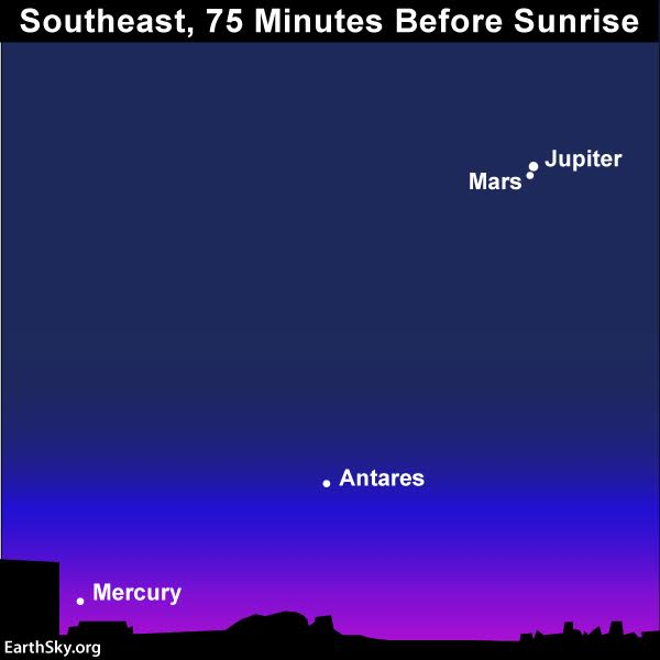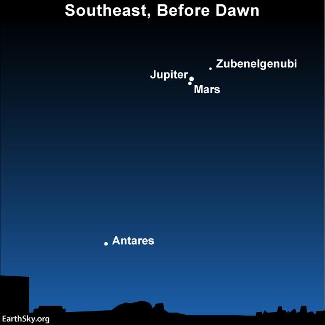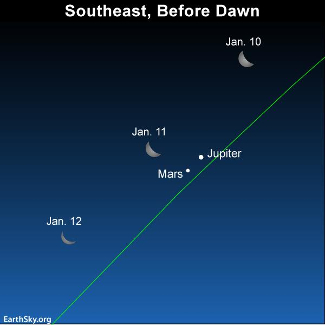|
Mars/Jupiter conjunction in Sunday morning sky |
|
January 6, 2018 |
 |
By Bruce McClure
EarthSky.org
 |
| If you’re
outside very early on January 7 – the
morning of the Mars/Jupiter conjunction,
you might not see Mercury. It might not
have risen yet. But you can see the star
Zubenelgenubi near the planets, and
bright reddish Antares below them. If,
that is, the clouds part. |
All week, before dawn, bright Jupiter has been
moving up toward fainter Mars in the predawn
sky. Before dawn on Sunday – January 7, 2018 –
Mars and Jupiter are in conjunction, with the
red planet Mars appearing about 0.25-degree south of
the giant planet Jupiter.
That’s about the
equivalent of one-half of the moon’s diameter.
This is the first conjunction of Mars and
Jupiter since October 15, 2017; and the next one
won’t be until March 20, 2020. You’ll find the
planets high in the sunrise half of your sky
before dawn.
Jupiter beams as the brightest starlike object
in the January 2018 morning sky, shining some 20
times more brilliantly than Mars.
The fainter,
red “star” near Jupiter will be Mars. Binoculars
will enhance the view – especially the
contrasting colors of the two planets – so grab
them before heading out the door.
Mars and Jupiter will be easy to spot on January
7. It’ll be more of a challenge to catch Mercury
as the predawn darkness gives way to dawn. Look
for the Mercury near your sunrise horizon.
Click
here for recommended almanacs; they can help you
find out Mercury’s rising time into your sky.
In the months ahead, Mars will seem to linger in
the sky before dawn, while Jupiter rises
earlier, and earlier, and thereby shifts away
from it. Jupiter’s opposition, when Earth will
pass between the sun and Jupiter – placing
Jupiter in our eastern sky at sunset – will come
in May.
Mars, too, will suddenly seem to start
brightening and moving toward the evening sky.
Its opposition – in late July 2018 – will be one
of the best for many years.
 |
| On the
mornings of January 10-12, 2018, the
waning crescent moon will sweep past the
planets Jupiter and Mars. |
As seen on the sky’s dome, both Mars and Jupiter
will be moving away from the star Zubenelgenubi
and toward the star Antares.
But Mars travels
through the constellations of the zodiac at a
much faster clip than does slow-plodding
Jupiter.
So Mars will pass 5-degrees north of Antares
on February 11, 2018, whereas Jupiter won’t pass
to the north of Antares until December, 2019.
In fact, you can use dazzling Jupiter as your
guide “star” to Zubenelgenubi, the alpha star in
the constellation Libra the Scales, for the most
of 2018.
When you contrast the brightness of Mars and
Jupiter in January 2018, you might find it hard
to believe that Mars will actually be the
brighter of these two luminaries in six more
months, around the time of its July 2018
opposition.
By the end of the first week of July
2018, Mars will finally catch up with Jupiter in
brightness.
Then in late July 2018, when Mars
comes closest to Earth for the year, Mars will
shine most brilliantly in Earth’s sky since
2003. Mars will outshine Jupiter by some 1.8
times in late July/early August 2018.
For a period of about two months, Mars will
supplant Jupiter as the fourth brightest
celestial body, after the sun, moon and Venus.
Mars’ reign as the fourth-brightest celestial
body (or third brightest in the nighttime sky,
after the moon and Venus) will last from about
July 7 to September 7.
Mars has a much greater range of brightness in
our sky than Jupiter does. That’s because Mars
is about 6.5 times more distant from Earth at
its farthest than at its closest. In contrast,
Jupiter is only about 1.5 times more distant at
its farthest than at it closest.
For instance, when Jupiter comes closest to
Earth for the year at its opposition on May 10,
2018, it’ll only be about 30-percent closer to
Earth, and approximately 1.9 times brighter,
than on January 7.
Yet, when Mars comes closest
to Earth for the year in late July 2018, it’ll
be about 85-percent closer to Earth, and nearly
50 times brighter, than it is on January 7. |
|
Questions or comments about this
letter?
Click here to e-mail! |
|
|
|
|

